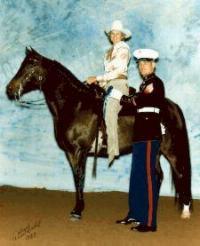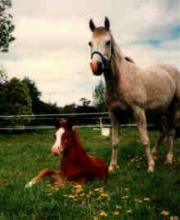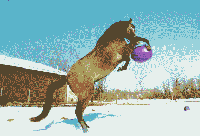| The Morab |  Desiderata's Dawn of Liberty Mtn Ranch |
The question most often asked about the Morab surrounds their status as a breed. Some misunderstand and consider the Morab a part-bred while others have termed them half-breeds. Morabs (the progeny of Morgan/Arabian breeding) are neither half-Morgans nor half-Arabians, but rather are a very distinct breed. Today's Morabs have proven over six generations that they transmit their distinguishing characteristics with a high degree of certainty to their progeny, putting the question of breed status to rest! Only foundation stock (first generation Morabs) can posses Morab registration, 1/2 Morgan registration in the Archival Morgan Record (AMR), and 1/2 Arabian registration in the Half Arabian Registry (IAHA). This makes first generation Morabs triple registrable, plus the various color registries. Succeeding generations of Morabs bred Morab to Morab are no longer registrable with either half registry.
 Menora First Knight, foaled Oct. 1996 Menora Morab & Morgan Stud, Australia |
When dealing with any breed of horse that was created
from two established purebred parent breeds, several questions inevitably are
asked; Can the Morab be considered a breed? Why breed a crossbred horse instead
of a purebred horse? How can you charge as much or more for what might be
considered a crossbred horse? Actually, these are all easily answered!
It seems the desire to combine the best traits of two treasured breeds, the Morgan and Arabian, has inspired breeders since the 1800's. A usual first reaction is similar to that of Morab breeder, Anita Messenger of Arkansas, "When we heard the word 'Morab,' our interest was pricked. Wow, what kind of horse could be produced by crossing the Arabian and Morgan breeds. We were soon to discover that Morabs are not only a registered breed, but a breed with a fascinating history..." |
Modern Morab breeders carefully select mares and stallions that will combine the best genetic traits of their breeds. This fusion of Morgan and Arabian characteristics is genetically complimentary and gives the resultant Morab enhanced beauty and strength.
Ancient desert horses of the Bedouins were bred for beauty, stamina, soundness, speed and disposition. Several centuries later, that same Arabian blood was part of a still unknown genetic formula that resulted in the legendary stallion, Justin Morgan. This one horse founded the Morgan horse, a uniquely American breed. The rugged terrain and harsh climate of Vermont in the late 1700's only served to enhance the merits of this hearty little stallion, who proved himself time and time again in tests of his incredible strength, speed, and endurance. These traits, plus his friendly, willing disposition were passed on with unfailing accuracy to his progeny, as they are now, over 200 years later.
Today's well-bred Morabs combine Morgan strength and depth with Arabian refinement and sensitivity. The Arabian horse, often called the "Drinker Of The Wind" for its powerful lungs, combined with the broad, powerful chest of the Morgan, gives the Morab a naturally superior breathing system.
Morabs possess a shorter back than other breeds (one backbone less), as does the Arabian. This shorter back, combined with the longer croup of the Morgan, endows the Morab with great strength and a smooth gait. These in turn enable Morabs to excel in Competitive and Endurance events and working off its powerful hindquarters, natural athletic ability that makes it well suited for the high performance demands of Dressage, Jumping and Cutting Horses.
Mature Morab's hooves and legs hold up well to excessive stress, since the Morgan contributes wonderful formation of bone and a medium length pastern, and the Arabian adds the broad, hard hoof and lower heel. This accounts for the almost nonexistent foot and leg problems of the Morab breed, and many breeders report that their Morabs are never shod and require minimum hoof trimming.
Muscular, yet refined, best describes the appearance of the mature Morab. Average height is 14.1 hands to 15.2 hands and there are a wide variety of colors and markings common to Morgans and Arabians. The Morab body is compact, of medium length, well-muscled, smooth and stylish. Large, dark expressive eyes are set off by a wide forehead. A thick, luxuriant mane and tail balances out its muscular build. The Morab's head may be straight to slightly dished with a big powerful jaw in contrast to a small muzzle with large, bold nostrils. The refined, sculpted beauty of the Arabian, joined with the Morgans dramatic natural style and stamina creates a elegantly powerful horse for use in the show ring, performance competition, as a working horse, or on the trail. Indeed, most Morabs comfortably switch back and forth in all these activities.
| Despite all the other highly prized traits of the Morab, most owners and breeders will cite the Morab's intelligent, dependable and affectionate nature as its most valued qualities. When the spirit and people-loving nature of the Arabian is added to the dependable, common sense of the Morgan, the resultant breed is one that cannot be beat in temperament, intelligence and willing attitude. That is why mature Morabs are so popular as mounts for children, amateur riders, senior citizens as well as those involved in spirited competition. |  Aspen Lane Tango of Rocky Mountain Morabs |
According to the United States Department of Agriculture, Handbook #394, "A breed of horse may be defined as a group of horses of common origin and possessing certain, well-defined, distinctive, uniformly transmitted characteristics that are not common to other horses ..."
Cross breeding between breeds can produce desirable horses, if the parents are of high quality, but often the resultant crossbred foals (even full brothers and sisters) do not show many like traits and may not even look alike. This is not true in the Morab; all well-bred Morabs have a consistently uniform look, with some degree of refinement; with second, third, fourth and successive generations showing very little if any change from the first generation. It is this ability to transmit their distinguishing characteristics to their progeny that make the Morab a distinct breed, rather than just another nice cross-bred horse.
History's first recorded Morab was Golddust (registered in the Morgan registry as #70), bred in 1855, who produced 302 foals and left 44 trotters of record. In the 1920's William Randolph Hearst bred a number of Morabs for use on the mountainous terrain of the Hearst San Simeon Ranch (registered in the Morgan registry with his Sunical prefix). In the 1940's the Swenson brothers produced outstanding stock horses crossing their Morgans with Arabians at their famous SMS Texas ranch. In the 1950's Martha Doyle Fuller developed a show quality Morab program at her California ranch and her daughter, M. Irene Miller, started the first Morab registry in 1973. The International Morab Registry™ now carries the distinction of maintaining the archives, gathering historical background and registering today's Morabs.
In summary, today's Morab is a carefully bred animal, representing the finest traits of both its founding parent breeds. Fusing Morgan and Arabian blood produces the "Magnificent Morab", an extremely versatile breed of exciting horses!
An essay by Linda Konichek for the IMR™.
GENERAL INFORMATION:
 |
Good saddle conformation, should be compact, medium length, well muscled, smooth and stylish. A Morab must display distinct refinement: the degree of refinement will vary with the breeding; however, it should always be apparent in the head and legs. |
QUALITY:
Dense bone with sufficient substance, well-developed joints and tendons,
and a fine, silky coat. The overall
appearance of the Morab will be pleasing, showing great strength, but never
coarse.
DISPOSITION:
Calm, affectionate, intelligent and dependable best describe the Morab.
COLORS:
Morabs may be any color and exhibit the white markings expressed by a Morgan or
Arabian: star, blaze, white stockings, etc.
Registry colors are: Bay, Black, Buckskin, Chestnut, Cremello, Dunn, Gray,
& Palomino.
Registry color patterns are: Solid, Roan, Overo, Leopard.
HEIGHT:
A mature Morab will generally range from 14.3 to 15.3 hands.
WEIGHT:
950 to 1200 pounds.
EYES:
Large, dark, expressive, bright, clear and set wide apart.
EARS:
Set wide apart, characteristically curved in at the top, fine pointed and
carried alertly.
FETLOCK:
Large, not round but rather wide.
MANE AND FORETOP:
Full and silky in texture.
THROATLATCH:
Clean and well defined, and never thick.
NECK:
Heavy in appearance but refined and of good length, displaying a natural
arching appearance. It should be smoothly joined to the shoulder and deepest at
the point of the shoulder. Stallions tend to have a more fully developed crest
than either a mare or gelding.
CHEST:
Good depth and width. A mature Morab is broad in the chest which is quite
noticeable through the heart, back ribs, and slightly
wider through the hip. This room and compaction of body structure gives the
Morab stamina as well as great speed.
WITHERS:
Defined, not too high, but should be slightly higher than the point of the
hip.
SHOULDERS:
Muscled of good length and slope.
BACK:
Short, broad, deep in the girth.
FORELEGS:
Long, sound, with flat bones and large joints, broad forearm, short cannon bone
free of meat. Tendons should be squarely set, well apart: when viewed from the
front, they should appear thin, and must be straight; viewed from the side they
will appear wide and strong.
BARREL:
Large and round, with well sprung close ribs, deep and full, yet with a
trim flank.
HIP:
Muscled, of good length with a horizontal pelvic build that endows the
Morab with a full-un-sloped croup. The shape of hindquarters and the pelvic
angle is the most apparent difference between the Morab and other breeds.
Hipbones never show on adults.
HIND LEGS:
Should be squarely set and so placed that the Morab turns on its
hindquarters with its legs well under it.
HOCKS:
Neither close together nor wider apart than the fetlocks when viewed from
the rear. Should be wide, deep and clean.
HOOF:
Medium sized, nearly round, open at the heel, smooth and dense but never
brittle.
PASTERNS:
Clean strong, medium length and should match the slope of the shoulder.
TAIL:
Set fairly high, carried gaily.
 |
WAY OF
MOVING: The Morab in action has a free flowing gait, working off its strong hindquarters and carries itself collected. The Morab can posses a natural action or a lower action depending on the breeding of the animal. |
To learn more about the history of the Morab click here
Provided since 1986 by:
The MORAB COMMUNITY NETWORK:
International Morab Breeders' Association Inc.
International Morab Registry™
Morab Publishing International
The Half Morab Registry
International Morab Breeders' Youth Association
RR 3 Box 235; Ava, MO 65608-9553
417-683-4426; fax 417-683-5708
For Registration information email: imr@morab.com
For Morab information email: imba@morab.com